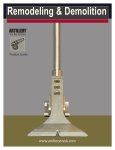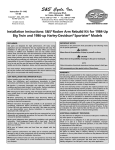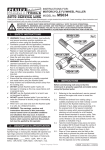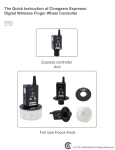Download PDF - Kirk Engines, Inc.
Transcript
KIRK ENGINES, INC. The following instructions are for the installation of the Analog Tachometer into the instrument panel of garden tractors powered by K-series, single cylinder Kohler engines. Please note – The Analog Tachometer is a precision made electronic instrument. Follow these instructions to ensure that wiring is properly connected such that no damage to instrument will result. This installation requires some knowledge of basic electrical wiring and the use of hand tools. Prior experience in doing something of this nature is highly suggested. If you fall short in any of these aforementioned categories, have someone skilled in the art do this for you. Figure on about 2 hours of labor to do a first-class job. Read these instructions thoroughly and study the wiring diagram before starting. The following tools and components will be necessary for installing this tachometer into the instrument panel of your tractor: 2⅛ inch diameter hole saw 14 or 16 gauge wire in lengths determined by installation distances and preferably in 3 different colors Solderless wire terminals to suit individual installation requirements Refer to the attached wiring diagram and follow these step-by-step instructions. 1) Disconnect the negative lead of the battery. 2) Locate a suitable spot on the instrument panel for the tachometer to be installed. Be sure to check for ample clearance behind the instrument panel such that tachometer housing will not interfere with any other components. On many tractors, the ammeter is located centrally. You may consider placing the tachometer in the center hole and moving the ammeter to the new hole you will be making, as the tachometer is the more important instrument to monitor. 3) Most hole saws use a ¼ inch pilot bit. It is suggested that a ¼ diameter hole be drilled first at the center point of the determined tachometer location. This will accurately guide the hole saw during the initial phase of the cut. Using a 2⅛ inch diameter hole saw, carefully bore a hole in the instrument panel to accept the gauge. 4) Remove the two bracket mounting nuts and mounting bracket from the back of the tachometer. Place tachometer into hole and refit mounting bracket and mounting nuts from the back side of instrument panel. Rotate instrument such that face is level, then tighten the bracket mounting nuts. Note: The mounting bracket comes very close to the three male spade connectors on the tachometer terminal strip. Use insulated female spade terminals on your wiring at this location to prevent accidental contact and shorting against the mounting bracket. 5) Measure and cut a length of wire that will run from the (+) terminal of the tachometer to the (+) side of the ignition coil. Crimp on appropriate terminals and attach. This wire supplies current to the tachometer for operation. 6) Measure and cut a length of wire that will run from the (S) terminal of the tachometer to the (-) side of the coil. Crimp on appropriate terminals and attach. This wire supplies the signal to the instrument. 7) Measure and cut a length of wire to run from the (-) terminal of the tachometer to a secure ground source on the tractor frame. Crimp on appropriate terminals and attach. The tachometer must be properly grounded to function. It is not grounded through the instrument case. 8) If your tractor is equipped with headlights, you may elect to use the optional tachometer backlight for viewing at night. Measure and cut a length of wire to run from one of the light socket spade terminals on the tachometer to the switched +12 V side of the headlight switch. Crimp on appropriate terminals and attach. 9) Measure and cut a length of wire that will run from the remaining light socket spade terminal to ground. This can be spliced into the ground lead running from the (-) terminal on the tachometer. Crimp on appropriate terminals and attach. 10) Connect the negative lead of the battery. 11) Start the engine and verify normal operation. Test instrument light by turning on headlight switch. This tachometer has been individually calibrated to be accurate within a maximum of +/2% of actual engine rpm. When used on a single cylinder engine with ignition signals generated every second revolution, the tachometer needle would oscillate or “dither” without dampening being applied. This instrument contains a dampening circuit to reduce the dithering effect which would otherwise be especially pronounced at idle. Dampening decreases the response rate slightly but produces a very consistent reading at steady-state conditions. Parameters to Monitor with the Analog Tachometer Engine Low Idle Speed – Most Kohler K-series engines idle well at 800-900 rpm. Use the tachometer to adjust idle speed to this value with a fully warmed-up engine. Engine High Idle Speed – Proper high idle speed adjustment is very important to obtain best power from your engine when a load is applied. Having a too-low of a setting gives the impression of a lack of power. The Kohler K-series engines, as with most small industrial engines, have a high idle speed requirement of 3600 rpm. High idle is defined as throttle control fully opened to the stop, with engine governor controlling speed to 3600 rpm, with no load applied to engine. Use the tachometer to adjust governor to obtain this high idle speed. Consult the Kohler Engine Service Manual for governor adjusting procedure. Governor Droop – Droop is defined as the rpm difference between the high idle rpm versus the loaded engine rpm when the carburetor throttle valve becomes fully open. Example – High idle speed is confirmed as 3600 rpm from tachometer reading. With throttle control at fully opened position, apply load to engine, such as a mower deck engaged when cutting thick, high grass. Keep an eye on the carburetor throttle valve. As engine is loaded, the governor will open the carburetor throttle in an attempt to maintain a 3600 rpm engine speed. When the carburetor throttle valve becomes fully opened against the wide-open-throttle stop, check the rpm reading on the tachometer. It should read approximately 3200 rpm. Thus the governor droop is 3600-3200 = 400 rpm. A 400 rpm droop is typical for the K-series Kohler engine. The governor may be adjusted for more or less droop by moving the governor spring to a different hole location (consult the Kohler Engine Service Manual for this procedure). Remember, less droop results in a faster engine load response but engine may hunt (surge) when not under load. Too much droop and engine gives the impression of lacking power. Maximum Safe Engine Speed – Pullers may want to set the high idle speed to 3900 rpm if club rules allow. Experience has shown that a maximum no load rpm of 4000 rpm is safe, but this should be considered the “red line” rpm for an engine running the stock, cast iron flywheel. Running above 4000 rpm could result in a disastrous flywheel explosion, causing harm or death to operator or bystanders. Never operate your engine above 4000 rpm if equipped with a stock, iron flywheel! Legal Stuff – Kirk Engines, Inc. warrants its Products to be free from defects in workmanship and materials at time of sale. Kirk Engines, Inc. offers Products that are installed by individual owners on their respective equipment. Therefore, Kirk Engines, Inc. cannot be held responsible for damage or loss of equipment due to faulty installation of Products, or use of said Products outside the scope and intent of their application. Analog Tachometer Wiring Diagram High voltage lead to spark plug Existing lead to points or ignition system Existing +12 volt lead from ignition switch (+) (-) 12V Coil ”S” lead to (-) terminal of coil (+) lead to (+) terminal of coil Instrument light socket Tachometer + S +12 volt lead to headlight switch (optional) Instrument light ground (optional) (-) lead to ground








